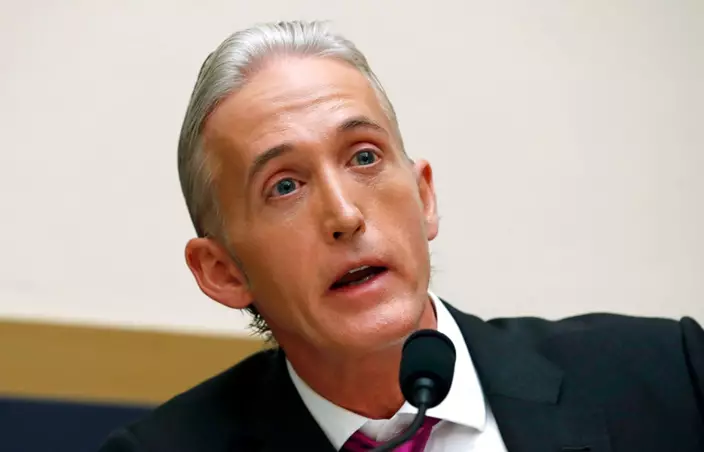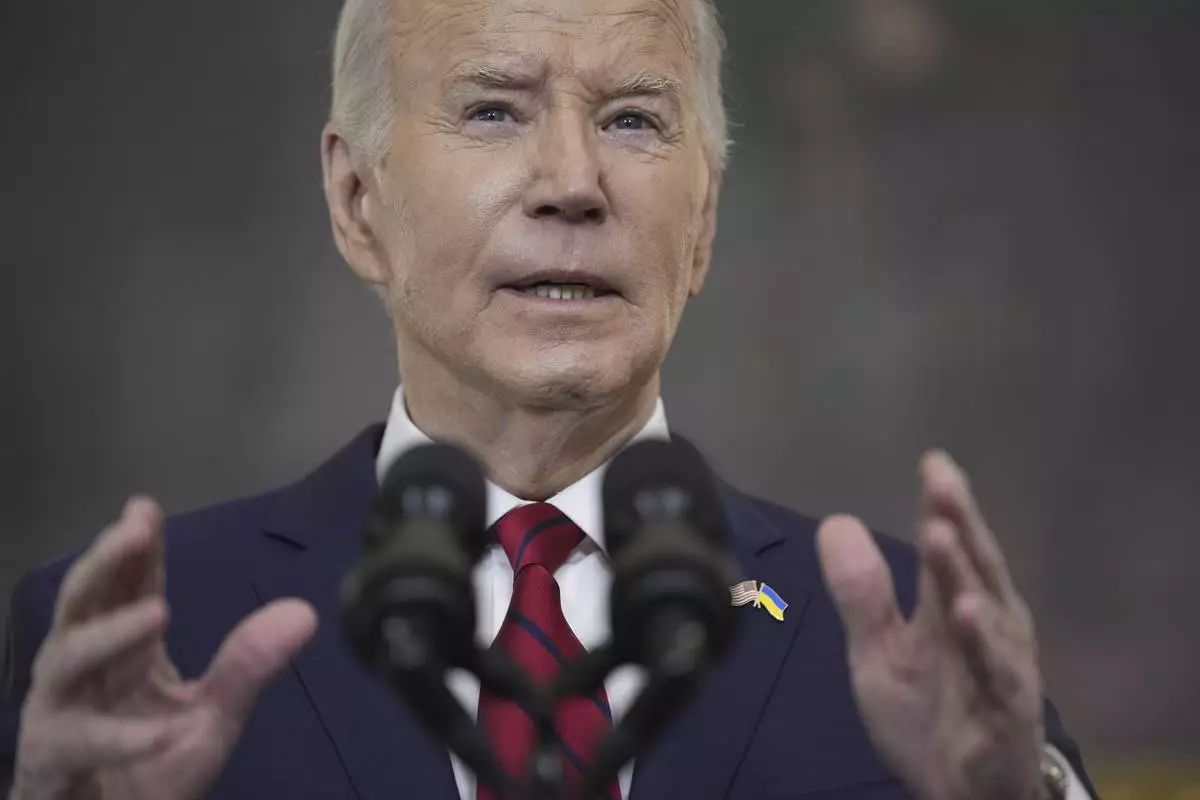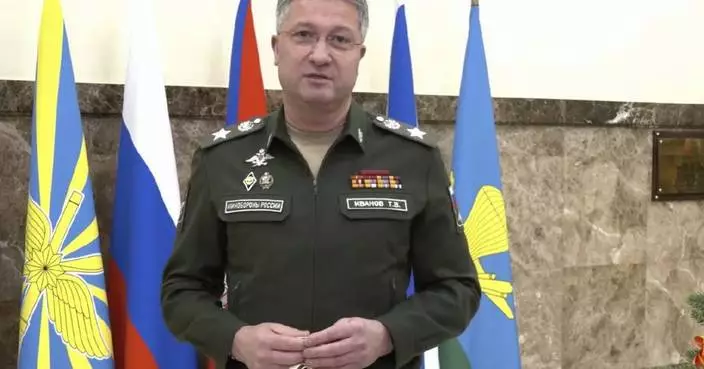There is no evidence that the FBI planted a "spy" on President Donald Trump's 2016 campaign, a senior House Republican said Wednesday, contradicting Trump's repeated insistence that the agency inserted a "spy for political reasons and to help Crooked Hillary win."
Rep. Trey Gowdy, chairman of the House Oversight Committee and a longtime Trump supporter, was briefed last week by the Justice Department and FBI following reports that investigators relied on a U.S. government informant in their probe of Russian election meddling.

FILE - In this Nov. 14, 2017 file photo, Rep. Trey Gowdy, R-S.C., questions Attorney General Jeff Sessions during a House Judiciary Committee hearing on Capitol Hill in Washington. The FBI acted properly in its investigation of contacts between President Donald Trump’s 2016 campaign and Russia, according to Gowdy, who recently received a classified briefing about the origins of the FBI probe. (AP Photo/Alex Brandon)
"I am even more convinced that the FBI did exactly what my fellow citizens would want them to do when they got the information they got and that it has nothing to do with Donald Trump," Gowdy, a South Carolina Republican, told Fox News on Tuesday.
On Wednesday, Gowdy said he had "never heard the term 'spy' used" and did not see evidence of it.
"Informants are used all day, every day by law enforcement," he told "CBS This Morning."
Asked about Gowdy's comments, White House press secretary Sarah Huckabee Sanders said the president "still has concerns about whether or not the FBI acted inappropriately having people in his campaign."
Sanders declined to say who in the campaign the president might suspect of providing information to the FBI. She said Trump also has concerns in general about the conduct of the FBI, citing the firing of former Deputy Director Andrew McCabe.
"There are a number of things that have been reported on and that show, I think not just for the president, but for a number of Americans a large cause for concern, and we'd like to see this fully looked into," Sanders said.
Gowdy's comments that undermine the president's claims are particularly striking because of his role as a powerful GOP watchdog who took on Democrat Hillary Clinton in his committee's investigation into the 2012 attack on an American mission in Benghazi, Libya, while she was secretary of state. The probe unearthed the existence of Clinton's private email server, which triggered an FBI inquiry and crippled her 2016 presidential campaign against Trump.
Trump has repeatedly pointed to, and at times embellished, reports that a longtime U.S. government informant approached members of his 2016 campaign during the presidential election in a possible bid to glean intelligence on Russian efforts to sway the election.
He has tweeted that it was "starting to look like one of the biggest political scandals in U.S. history." He has also rejected conclusions by America's intelligence agencies that the Russian government was trying to help him beat Clinton.
Several news outlets including The Washington Post, The Wall Street Journal and NBC News have identified an FBI confidential source as Stefan A. Halper.
Halper, an academic at the University of Cambridge who served in past Republican administrations, was not a part of Trump's campaign, but the news outlets have reported that he reached out to some Trump advisers to gather information as part of the Russia investigation.
Trump's legal team has expressed interest in seeing classified information about the origins of the FBI investigation to prepare the president for an interview with special counsel Robert Mueller, who is now leading the federal investigation into possible ties between Trump's campaign and Russia.
"The folks who have seen the information have the same perspective," Gowdy said. "The folks who have not seen the information, I don't know what informs their perspective."
Gowdy, who plans to retire from Congress at the end of the current term, did express support for Trump's "frustration" with Attorney General Jeff Sessions, who recused himself in May 2017 from the Russia probe based on a possible conflict of interest. The recusal of Sessions, an early backer of Trump's presidential bid, followed the revelation that he had two previously undisclosed interactions during the 2016 campaign with the Russian ambassador.
Gowdy told CBS that Trump is just "expressing frustration that Attorney General Sessions should have shared these reasons for recusal before he took the job. Not afterward."
Trump tweeted out Gowdy's comments on Sessions, including his saying that "there are lots of really good lawyers in the country" and that the president "could have picked someone else" for the top Justice Department job.
"And I wish I did!" Trump wrote.
Trump did not reference Gowdy's comments that there was no evidence of the FBI planting a spy in his campaign.
WASHINGTON (AP) — Ukraine for the first time has begun using long-range ballistic missiles provided secretly by the United States, bombing a Russian military airfield in Crimea last week and Russian forces in another occupied area overnight, American officials said Wednesday.
Long sought by Ukrainian leaders, the new missiles give Ukraine nearly double the striking distance — up to 300 kilometers (190 miles) — that it had with the mid-range version of the weapon that it received from the U.S. last October. One of the officials said the U.S. is providing more of these missiles in a new military aid package signed by President Joe Biden on Wednesday.
Biden approved delivery of the long-range Army Tactical Missile System, known as ATACMS, in early March, and the U.S. included a “significant” number of them in a $300 million aid package announced at the time, one official said.
The two U.S. officials, who spoke on condition of anonymity to discuss the delivery before it became public, would not provide the exact number of missiles given last month or in the latest aid package, which totals about $1 billion.
Ukraine has been forced to ration its weapons and is facing increasing Russian attacks. Ukraine had been begging for the long-range system because the missiles provide a critical ability to strike Russian targets that are farther away, allowing Ukrainian forces to stay safely out of range.
Information about the delivery was kept so quiet that lawmakers and others in recent days have been demanding that the U.S. send the weapons — not knowing they were already in Ukraine.
For months, the U.S. resisted sending Ukraine the long-range missiles out of concern that Kyiv could use them to hit deep into Russian territory, enraging Moscow and escalating the conflict. That was a key reason the administration sent the mid-range version, with a range of about 160 kilometers (roughly 100 miles), in October instead.
A senior U.S. military official said Wednesday that the White House and military planners looked carefully at the risks of providing long-range fires to Ukraine and determined that the time was right to provide them now.
Adm. Christopher Grady, vice chairman of the Joint Chiefs of Staff, told The Associated Press in an interview that long-range weapons will help Ukraine take out Russian logistics nodes and troop concentrations that are not on the front lines. He declined to identify what specific weapons were being provided but said they will be “very disruptive if used properly, and I’m confident they will be.”
Like many of the other sophisticated weapons systems provided to Ukraine, the administration weighed whether their use would risk further escalating the conflict.
“I think the time is right, and the boss (Biden) made the decision the time is right to provide these based on where the fight is right now,” Grady said Wednesday. “I think it was a very well considered decision, and we really wrung it out — but again, any time you introduce a new system, any change — into a battlefield, you have to think through the escalatory nature of it.”
Ukrainian officials haven’t publicly acknowledged the receipt or use of long-range ATACMS. But in thanking Congress for passing the new aid bill Tuesday, Ukrainian President Volodymyr Zelenskyy noted on the social platform X that “Ukraine’s long-range capabilities, artillery and air defense are extremely important tools for the quick restoration of a just peace.”
One of the U.S. officials said the Biden administration warned Russia last year that if Moscow acquired and used long-range ballistic missiles in Ukraine, Washington would provide the same capability to Kyiv.
Russia got some of those weapons from North Korea and has used them on the battlefield in Ukraine, said the official, prompting the Biden administration to greenlight the new long-range missiles.
The U.S. had refused to confirm that the long-range missiles were given to Ukraine until they were actually used on the battlefield and Kyiv leaders approved the public release. One official said the weapons were used early last week to strike the airfield in Dzhankoi, a city in Crimea, a peninsula that Russia seized from Ukraine in 2014. They were used again overnight east of the occupied city of Berdyansk.
Videos on social media last week showed the explosions at the military airfield, but officials at the time would not confirm it was the ATACMS.
Ukraine’s first use of the weapon came as political gridlock in Congress had delayed approval of a $95 billion foreign aid package for months, including funding for Ukraine, Israel and other allies. Facing acute shortages of artillery and air defense systems, Ukraine has been rationing its munitions as U.S. funding was delayed.
With the war now in its third year, Russia used the delay in U.S. weapons deliveries and its own edge in firepower and personnel to step up attacks across eastern Ukraine. It has increasingly used satellite-guided gliding bombs — dropped from planes from a safe distance — to pummel Ukrainian forces beset by a shortage of troops and ammunition.
The mid-range missiles provided last year, and some of the long-range ones sent more recently, carry cluster munitions that open in the air when fired, releasing hundreds of bomblets rather than a single warhead. Others sent recently have a single warhead.
One critical factor in the March decision to send the weapons was the U.S. Army’s ability to begin replacing the older ATACMS. The Army is now buying the Precision Strike Missile, so is more comfortable taking ATACMS off the shelves to provide to Ukraine, the official said.

President Joe Biden speaks before signing a $95 billion Ukraine aid package that also includes support for Israel, Taiwan, and other allies, in the State Dining Room of the White House, Wednesday, April 24, 2024, in Washington. (AP Photo/Evan Vucci)

FILE - A Ukrainian national flag waves over the center of Kharkiv, Ukraine's second-largest city, Feb. 16, 2022. U.S. officials say Ukraine for the first time has begun using long-range ballistic missiles, striking a Russian military airfield in Crimea and Russian troops in another occupied area overnight. (AP Photo/Mstyslav Chernov, File)

FILE - In this image provided by the U.S. Army, soldiers, from the 3rd Battalion, 321st Field Artillery Regiment of the 18th Field Artillery Brigade out of Fort Bragg N.C., conduct live fire testing at White Sands Missile Range, N.M., on Dec. 14, 2021, of early versions of the Army Tactical Missile System. U.S. officials say Ukraine for the first time has begun using long-range ballistic missiles, striking a Russian military airfield in Crimea and Russian troops in another occupied area overnight. The strikes come about a month after the U.S. secretly provided the weapons so that Ukraine could strike targets up to 190 miles away. (John Hamilton/U.S. Army via AP, file)













